27. The Sixties
¶ 1
Leave a comment on paragraph 1 0
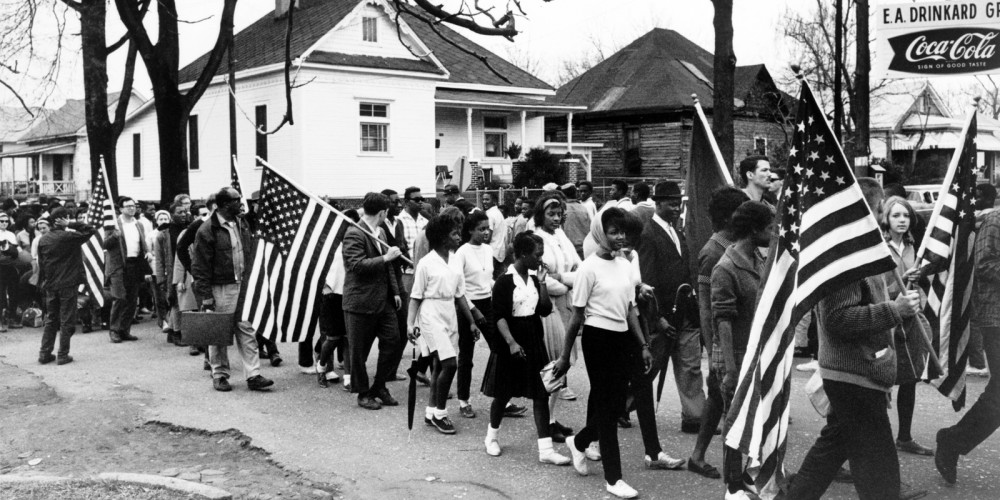 “Participants, some carrying American flags, marching in the civil rights march from Selma to Montgomery, Alabama in 1965,” via Library of Congress.
“Participants, some carrying American flags, marching in the civil rights march from Selma to Montgomery, Alabama in 1965,” via Library of Congress.
*Each summer, our editorial team integrates feedback from scholars and instructors to produce an improved draft for the following academic year. We may make small, grammatical corrections during the academic year, but more substantial improvements are made each summer. For more information about our feedback and revision process, please see our feedback instructions. Unfortunately, we are not able to acknowledge all of the excellent feedback we receive during the academic year. But please know that we thank you deeply for helping to show that a collaborative, free, and online textbook can maintain the highest standards of professional excellence.*
I. Introduction
¶ 3 Leave a comment on paragraph 3 0 Perhaps no decade is so immortalized in American memory as the 1960s. Couched in the colorful rhetoric of peace and love, complemented by stirring images of the civil rights movement, and fondly remembered for its music, art, and activism, for many the decade brought hopes for a more inclusive, forward-thinking nation. But the decade was also plagued by strife, tragedy, and chaos. It was the decade of the Vietnam War, of inner-city riots, and assassinations that seemed to symbolize the crushing of a new generation’s idealism. A decade of struggle and disillusionment rocked by social, cultural, and political upheaval, the 1960s are remembered because so much changed, and because so much did not.
¶ 4 Leave a comment on paragraph 4 0
II. Kennedy and Cuba
¶ 5 Leave a comment on paragraph 5 0 The decade’s political landscape began with a watershed presidential election. Americans were captivated by the 1960 race between Republican Vice President Richard Nixon and Democratic Senator John F. Kennedy, two candidates who pledged to move the nation forward and invigorate an economy experiencing the worst recession since the Great Depression. Kennedy promised to use federal programs to strengthen the economy and address pockets of longstanding poverty, while Nixon called for a reliance on private enterprise and reduction of government spending. Both candidates faced criticism as well; Nixon had to defend Dwight Eisenhower’s domestic policies, while Kennedy, who was attempting to become the first Catholic president, had to counteract questions about his faith and convince voters that he was experienced enough to lead.
¶ 6 Leave a comment on paragraph 6 0 One of the most notable events of the Nixon-Kennedy presidential campaign was their televised debate in September, the first of its kind between major presidential candidates. The debate focused on domestic policy and provided Kennedy with an important moment to present himself as a composed, knowledgeable statesman. In contrast, Nixon, an experienced debater who faced higher expectations, looked sweaty and defensive. Radio listeners famously thought the two men performed equally well, but the TV audience was much more impressed by Kennedy, giving him an advantage in subsequent debates. Ultimately, the election was extraordinarily close; in the largest voter turnout in American history up to that point, Kennedy bested Nixon by less than one percentage point (34,227,096 to 34,107,646 votes). Although Kennedy’s lead in electoral votes was more comfortable at 303 to 219, the Democratic Party’s victory did not translate in Congress, where Democrats lost a few seats in both houses. As a result, Kennedy entered office in 1961 without the mandate necessary to achieve the ambitious agenda he would refer to as the New Frontier.
¶ 7 Leave a comment on paragraph 7 0 The United States entered the 1960s unaccustomed to stark foreign policy failures, having emerged from World War II as a global superpower before waging a Cold War against the Soviet Union in the 1950s. In the new decade, unsuccessful conflicts in Cuba and Vietnam would yield embarrassment, fear, and tragedy, stunning a nation used to triumph and altering the way many thought of America’s role in international affairs.
¶ 8 Leave a comment on paragraph 8 0 On January 8, 1959, Fidel Castro and his revolutionary army initiated a new era of Cuban history. Having ousted the corrupt Cuban President Fulgenico Batista, who had fled Havana on New Year’s Eve, Castro and his rebel forces made their way triumphantly through the capital city’s streets. The United States, who had long propped up the Batista’s corrupt regime, had withdrawn support and, initially, expressed sympathy for Castro’s new government, which was immediately granted diplomatic recognition. But President Dwight Eisenhower and members of his administration were wary. The new Cuban government soon instituted leftist economic policies centered around agrarian reform, land redistribution, and the nationalization of private enterprises. Cuba’s wealthy and middle class citizens fled the island in droves. Many settled in Miami, Florida, and other American cities.
¶ 9 Leave a comment on paragraph 9 0 The relationship between Cuba and the United States deteriorated rapidly. On October 19, 1960, the United States instituted a near-total trade embargo to economically isolate the Cuban regime, and, in January 1961, the two nations broke off formal diplomatic relations. The Central Intelligence Agency, acting under the mistaken belief that the Castro government lacked popular support and that Cuban citizens would revolt if given the opportunity, began to recruit members of the exile community to participate in an invasion of the island. On April 16, 1961, an invasion force consisting primarily of Cuban émigrés landed on Girón Beach at the Bay of Pigs. Cuban soldiers and civilians quickly overwhelmed the exiles, many of whom were taken prisoner. The Cuban government’s success at thwarting the Bay of Pigs invasion did much to legitimize the new regime and was a tremendous embarrassment for the Kennedy administration.
¶ 10 Leave a comment on paragraph 10 0 As the political relationship between Cuba and the United States disintegrated, the Castro government became more closely aligned with the Soviet Union. This strengthening of ties set the stage for the Cuban Missile Crisis, perhaps the most dramatic foreign policy crisis in the history of the United States. In 1962, in response to the US’s long-time maintenance of a nuclear arsenal in Turkey and at the invitation of the Cuban government, the Soviet Union deployed nuclear missiles in Cuba. On October 14, 1962, American spy planes detected the construction of missile launch sites, and on October 22, President Kennedy addressed the American people to alert them to this threat. Over the course of the next several days, the world watched in horror as the United States and the Soviet Union hovered on the brink of nuclear war. Finally, on October 28, the Soviet Union agreed to remove its missiles from Cuba in exchange for a U.S. agreement to remove its missiles from Turkey and a formal pledge that the United States would not invade Cuba, and the crisis was resolved peacefully.
¶ 11
Leave a comment on paragraph 11 0
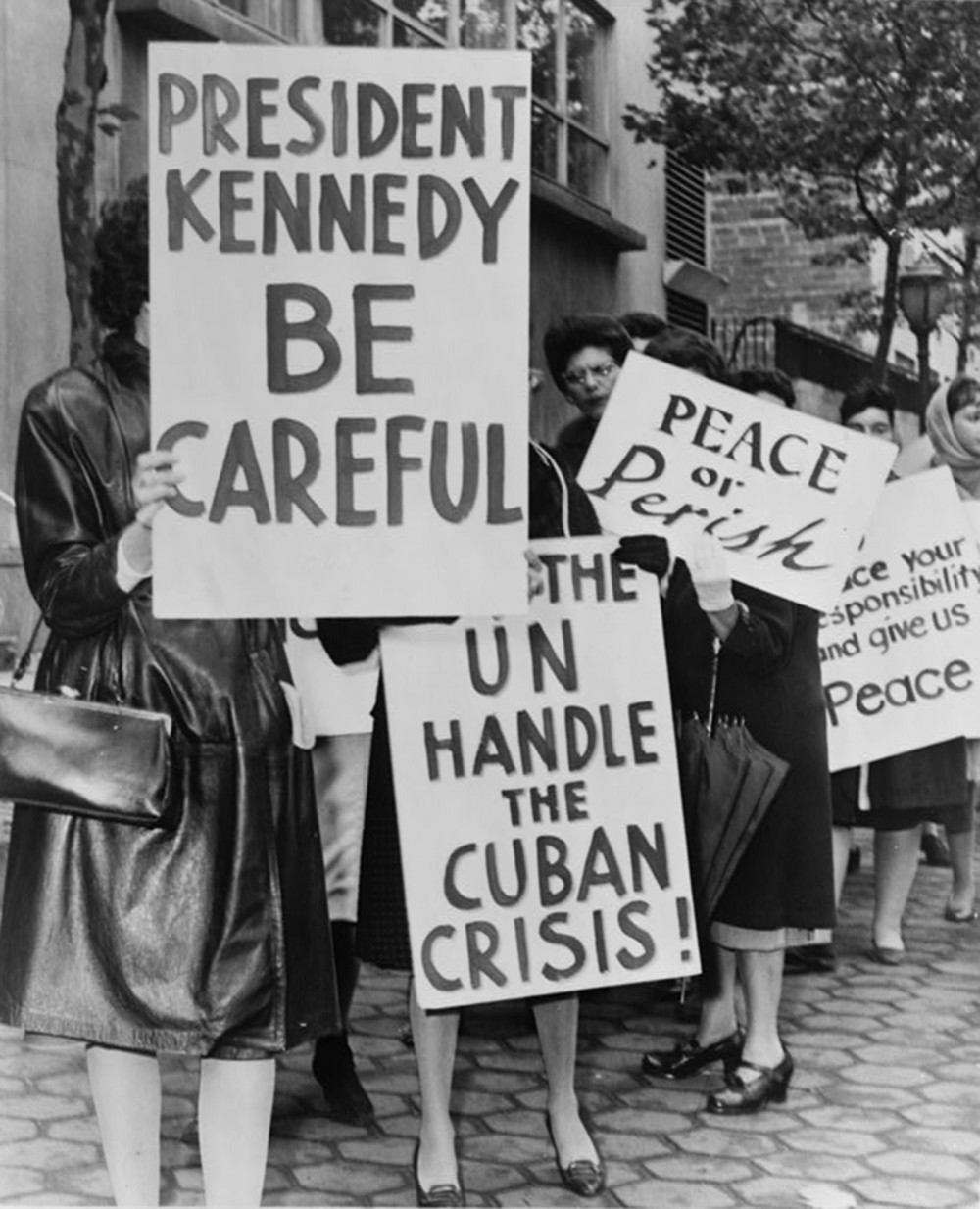 The Cuban Missile Crisis was a time of great fear throughout America. Women in this photograph urged President Kennedy to be cautious of instigating war. Phil Stanziola, “800 women strikers for peace on 47 St near the UN Bldg,” 1962. Library of Congress.
The Cuban Missile Crisis was a time of great fear throughout America. Women in this photograph urged President Kennedy to be cautious of instigating war. Phil Stanziola, “800 women strikers for peace on 47 St near the UN Bldg,” 1962. Library of Congress.
¶ 12 Leave a comment on paragraph 12 0 Though the Cuban Missile Crisis temporarily halted the flow of Cuban refugees into the United States, emigration began again in earnest in the mid-1960s. In 1965, the Johnson administration and the Castro government brokered a deal that facilitated the reunion of families that had been separated by earlier waves of migration, opening the door for thousands to leave the island. In 1966 President Lyndon B. Johnson signed the Cuban Adjustment Act, a law allowing Cuban refugees to become permanent residents. Over the course of the 1960s, hundreds of thousands of Cubans left their homeland and built new lives in America.
¶ 13 Leave a comment on paragraph 13 0
III. The Civil Rights Movement Continues
¶ 14 Leave a comment on paragraph 14 1 So much of the energy and character of “the sixties” emerged from the civil rights movement, which won its greatest victories in the early years of the decade. The movement itself was changing. Many of the civil rights activists pushing for school desegregation in the 1950s were middle-class and middle-aged. In the 1960s, a new student movement arose whose members wanted swifter changes in the segregated South. Confrontational protests, marches, boycotts, and sit-ins accelerated. ((For the major events of the civil rights movement, see Taylor Branch, Parting the waters: America in the King years, 1954–1963 (New York: Simon & Schuster, 1988); Pillar of Fire: America in the King years, 1963–1965 (New York: Simon & Schuster, 1998); and At Canaan’s Edge: America in the King Years, 1965-68 (New York: Simon & Schuster, 2007).))
¶ 15 Leave a comment on paragraph 15 0 The tone of the modern U.S. civil rights movement changed at a North Carolina department store in 1960, when four African American students participated in a “sit-in” at a whites-only lunch counter. The 1960 Greensboro sit-ins were typical. Activists sat at segregated lunch counters in an act of defiance, refusing to leave until being served and willing to be ridiculed, attacked, and arrested if they were not. It drew resistance but it forced the desegregation of Woolworth’s department store. It prompted copycat demonstrations across the South. The protests offered evidence that student-led direct action could enact social change and established the civil rights movement’s direction in the forthcoming years. ((Branch, Parting.))
¶ 16 Leave a comment on paragraph 16 0 The following year, civil rights advocates attempted a bolder variation of a “sit-in” when they participated in the Freedom Rides. Activists organized interstate bus rides following a Supreme Court decision outlawing segregation on public buses and trains. The rides intended to test the court’s ruling, which many southern states had ignored. An interracial group of Freedom Riders boarded buses in Washington D.C. with the intention of sitting in integrated patterns on the buses as they traveled through the Deep South. On the initial rides in May 1961, the riders encountered fierce resistance in Alabama. Angry mobs composed of KKK members attacked riders in Birmingham, burning one of the buses and beating the activists who escaped. Despite the fact that the first riders abandoned their trip and decided to fly to their destination, New Orleans, civil rights activists remained vigilant. Additional Freedom Rides launched through the summer and generated national attention amid additional violent resistance. Ultimately, the Interstate Commerce Commission enforced integrated interstate buses and trains in November 1961. ((Raymond Arsenault, Freedom Riders: 1961 and the Struggle for Racial Justice (New York: Oxford University Press, 2006).))
¶ 17 Leave a comment on paragraph 17 1 In the fall of 1961, civil rights activists descended on Albany, a small city in southwest Georgia. A place known for entrenched segregation and racial violence, Albany seemed an unlikely place for black Americans to rally and demand civil rights gains. The activists there, however, formed the Albany Movement, a coalition of civil rights organizers that included members of the Student Nonviolent Coordinating Committee (SNCC, or, “snick”), the Southern Christian Leadership Conference (SCLC), and the NAACP. But in Albany the movement was stymied by police chief Laurie Pritchett, who launched mass arrests but refused to engage in police brutality and bailed out leading officials to avoid negative media attention. It was a peculiar scene, and a lesson for southern acvtivists. ((Clayborne Carson, In Struggle: SNCC and the Black Awakening of the 1960s (Cambridge: Harvard University Press, 1980); Adam Fairclough, To Redeem the Soul of America: The Southern Christian Leadership Conference & Martin Luther King (Athens: University of Georgia Press, 1987).))
¶ 18 Leave a comment on paragraph 18 0 The Albany Movement included elements of a Christian commitment to social justice in its platform, with activists stating that all people were “of equal worth” in God’s family and that “no man may discriminate against or exploit another.” In many instances in the 1960s, black Christianity propelled civil rights advocates to action and demonstrated the significance of religion to the broader civil rights movement. King’s rise to prominence underscored the role that African American religious figures played in the 1960s civil rights movement. Protestors sang hymns and spirituals as they marched. Preachers rallied the people with messages of justice and hope. Churches hosted meetings, prayer vigils, and conferences on nonviolent resistance. The moral thrust of the movement strengthened African American activists while also confronting white society by framing segregation as a moral evil. ((David L. Chappell, A Stone of Hope: Prophetic Religion and the Death of Jim Crow (Chapel Hill: University of North Carolian Press, 2005).))
¶ 19 Leave a comment on paragraph 19 0 As the civil rights movement garnered more followers and more attention, white resistance stiffened. In October 1962, James Meredith became the first African American student to enroll at the University of Mississippi. Meredith’s enrollment sparked riots on the Oxford campus, prompting President John F. Kennedy to send in U.S. Marshals and National Guardsmen to maintain order. On an evening known infamously as the Battle of Ole Miss, segregationists clashed with troops in the middle of campus, resulting in two deaths and hundreds of injuries. Violence despite federal intervention served as a reminder of the strength of white resistance to the civil rights movement, particularly in the realm of education. ((Branch, Parting.))
¶ 20
Leave a comment on paragraph 20 0
![James Meredith, accompanied by U.S. Marshalls, walks to class at the University of Mississippi in 1962. Meredith was the first African-American student admitted to the still segregated Ole Miss. Marion S. Trikosko, “Integration at Ole Miss[issippi] Univ[ersity],” 1962. Library of Congress, http://www.loc.gov/pictures/item/2003688159/.](http://www.americanyawp.com/text/wp-content/uploads/04292v-1000x653.jpg) James Meredith, accompanied by U.S. Marshalls, walks to class at the University of Mississippi in 1962. Meredith was the first African-American student admitted to the still segregated Ole Miss. Marion S. Trikosko, “Integration at Ole Miss[issippi] Univ[ersity],” 1962. Library of Congress, http://www.loc.gov/pictures/item/2003688159/.The following year, 1963, was perhaps the decade’s most eventful year for civil rights. In April and May, the SCLC organized the Birmingham Campaign, a broad campaign of direct action aiming to topple segregation in Alabama’s largest city. Activists used business boycotts, sit-ins, and peaceful marches as part of the campaign. SCLC leader Martin Luther King Jr. was jailed, prompting his famous handwritten letter urging not only his nonviolent approach but active confrontation to directly challenge injustice. The campaign further added to King’s national reputation and featured powerful photographs and video footage of white police officers using fire hoses and attack dogs on young African American protesters. It also yielded an agreement to desegregate public accommodations in the city: activists in Birmingham scored a victory for civil rights and drew international praise for the nonviolent approach in the face of police-sanctioned violence and bombings. ((Branch, Parting.))
James Meredith, accompanied by U.S. Marshalls, walks to class at the University of Mississippi in 1962. Meredith was the first African-American student admitted to the still segregated Ole Miss. Marion S. Trikosko, “Integration at Ole Miss[issippi] Univ[ersity],” 1962. Library of Congress, http://www.loc.gov/pictures/item/2003688159/.The following year, 1963, was perhaps the decade’s most eventful year for civil rights. In April and May, the SCLC organized the Birmingham Campaign, a broad campaign of direct action aiming to topple segregation in Alabama’s largest city. Activists used business boycotts, sit-ins, and peaceful marches as part of the campaign. SCLC leader Martin Luther King Jr. was jailed, prompting his famous handwritten letter urging not only his nonviolent approach but active confrontation to directly challenge injustice. The campaign further added to King’s national reputation and featured powerful photographs and video footage of white police officers using fire hoses and attack dogs on young African American protesters. It also yielded an agreement to desegregate public accommodations in the city: activists in Birmingham scored a victory for civil rights and drew international praise for the nonviolent approach in the face of police-sanctioned violence and bombings. ((Branch, Parting.))
¶ 21 Leave a comment on paragraph 21 0
¶ 22 Leave a comment on paragraph 22 0
¶ 23 Leave a comment on paragraph 23 0
¶ 24 Leave a comment on paragraph 24 0
¶ 25
Leave a comment on paragraph 25 0
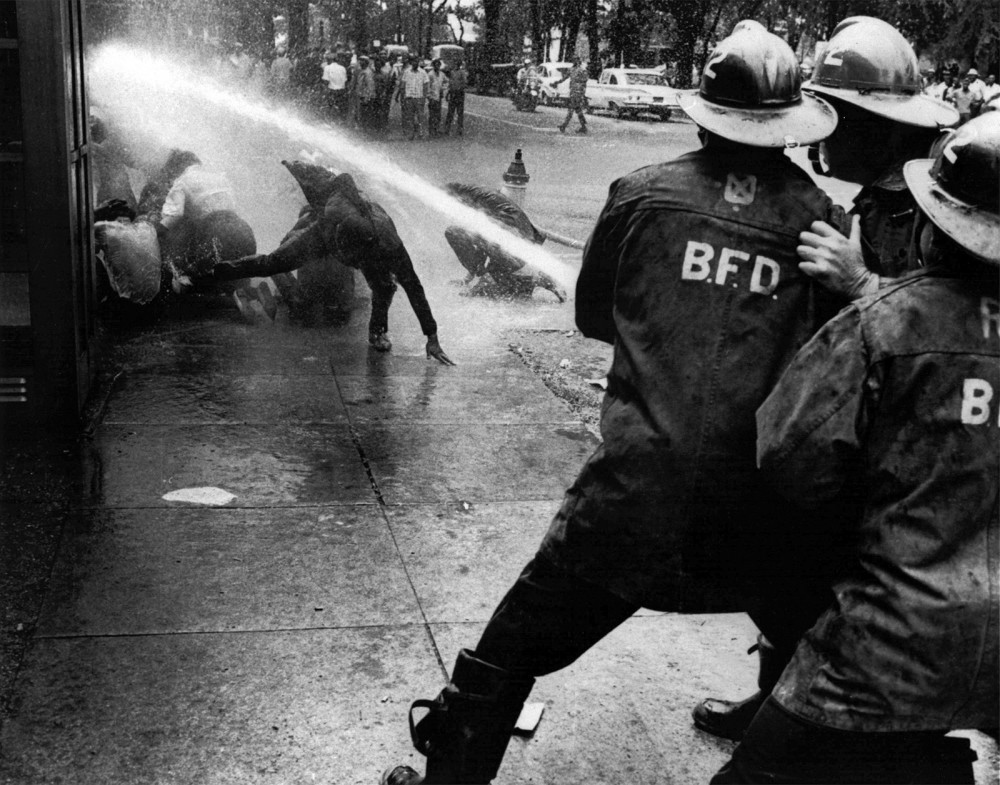 Images of police brutality against peaceful Civil Rights demonstrators shocked many Americans and helped increase support for the movement. Photograph by Bill Hudson. Birmingham, Alabama. 1964. Source.
Images of police brutality against peaceful Civil Rights demonstrators shocked many Americans and helped increase support for the movement. Photograph by Bill Hudson. Birmingham, Alabama. 1964. Source.
¶ 26 Leave a comment on paragraph 26 0 White resistance magnified. While much of the rhetoric surrounding the 1960s focused on a younger, more liberal generation’s progressive ideas, conservatism maintained a strong presence on the American political scene. Few political figures in the decade embodied the working-class, conservative views held by millions of white Americans quite like George Wallace. Wallace’s vocal stance on segregation was immortalized in his 1963 inaugural address as Alabama governor with the phrase: “Segregation now, segregation tomorrow, segregation forever!” Just as the civil rights movement began to gain unprecedented strength, Wallace became the champion of the many white southerners opposed to the movement. Consequently, Wallace was one of the best examples of the very real opposition civil rights activists faced in the late twentieth century. ((Dan T. Carter, The Politics of Rage: George Wallace, the Origins of the New Conservatism, and the Transformation of American Politics (Baton Rouge: Louisiana University Press, 2000).))
¶ 27 Leave a comment on paragraph 27 0 As governor, Wallace loudly supported segregation. His efforts were symbolic, but they earned him national recognition as a political figure willing to fight for what many southerners saw as their traditional way of life. In June 1963, just five months after becoming governor, in his “Stand in the Schoolhouse Door,” Wallace famously stood in the door of a classroom building to protest integration at the University of Alabama. President Kennedy addressed the nation that evening, criticizing Wallace and calling for a comprehensive civil rights bill. A day later, civil rights leader Medgar Evers was assassinated at his home in Jackson, Mississippi.
¶ 28
Leave a comment on paragraph 28 0
![Alabama governor George Wallace stands defiantly at the door of the University of Alabama, blocking the attempted integration of the school. Wallace was perhaps the most notoriously pro-segregation politician of the 1960s, proudly proclaiming in his 1963 inaugural address “segregation now, segregation tomorrow, segregation forever.” Warren K. Leffler, “[Governor George Wallace attempting to block integration at the University of Alabama],” June 11, 1963. Library of Congress, http://www.loc.gov/pictures/item/2003688161/.](http://www.americanyawp.com/text/wp-content/uploads/04294v1-1000x666.jpg) Alabama governor George Wallace stands defiantly at the door of the University of Alabama, blocking the attempted integration of the school. Wallace was perhaps the most notoriously pro-segregation politician of the 1960s, proudly proclaiming in his 1963 inaugural address “segregation now, segregation tomorrow, segregation forever.” Warren K. Leffler, “[Governor George Wallace attempting to block integration at the University of Alabama],” June 11, 1963. Library of Congress.That summer, civil rights leaders organized the August 1963 March on Washington. The march called for, among other things, civil rights legislation, school integration, an end to discrimination by public and private employers, job training for the unemployed, and a raise in the minimum wage. On the steps of the Lincoln Memorial, King delivered his famous “I Have a Dream” speech, an internationally renowned call for civil rights that raised the movement’s profile to new heights and put unprecedented pressure on politicians to pass meaningful civil rights legislation. ((Branch, Parting.))
Alabama governor George Wallace stands defiantly at the door of the University of Alabama, blocking the attempted integration of the school. Wallace was perhaps the most notoriously pro-segregation politician of the 1960s, proudly proclaiming in his 1963 inaugural address “segregation now, segregation tomorrow, segregation forever.” Warren K. Leffler, “[Governor George Wallace attempting to block integration at the University of Alabama],” June 11, 1963. Library of Congress.That summer, civil rights leaders organized the August 1963 March on Washington. The march called for, among other things, civil rights legislation, school integration, an end to discrimination by public and private employers, job training for the unemployed, and a raise in the minimum wage. On the steps of the Lincoln Memorial, King delivered his famous “I Have a Dream” speech, an internationally renowned call for civil rights that raised the movement’s profile to new heights and put unprecedented pressure on politicians to pass meaningful civil rights legislation. ((Branch, Parting.))
¶ 29 Leave a comment on paragraph 29 0
¶ 30 Leave a comment on paragraph 30 0
¶ 31 Leave a comment on paragraph 31 0
¶ 32 Leave a comment on paragraph 32 0
¶ 33 Leave a comment on paragraph 33 0
¶ 34 Leave a comment on paragraph 34 0
¶ 35 Leave a comment on paragraph 35 0
¶ 36
Leave a comment on paragraph 36 0
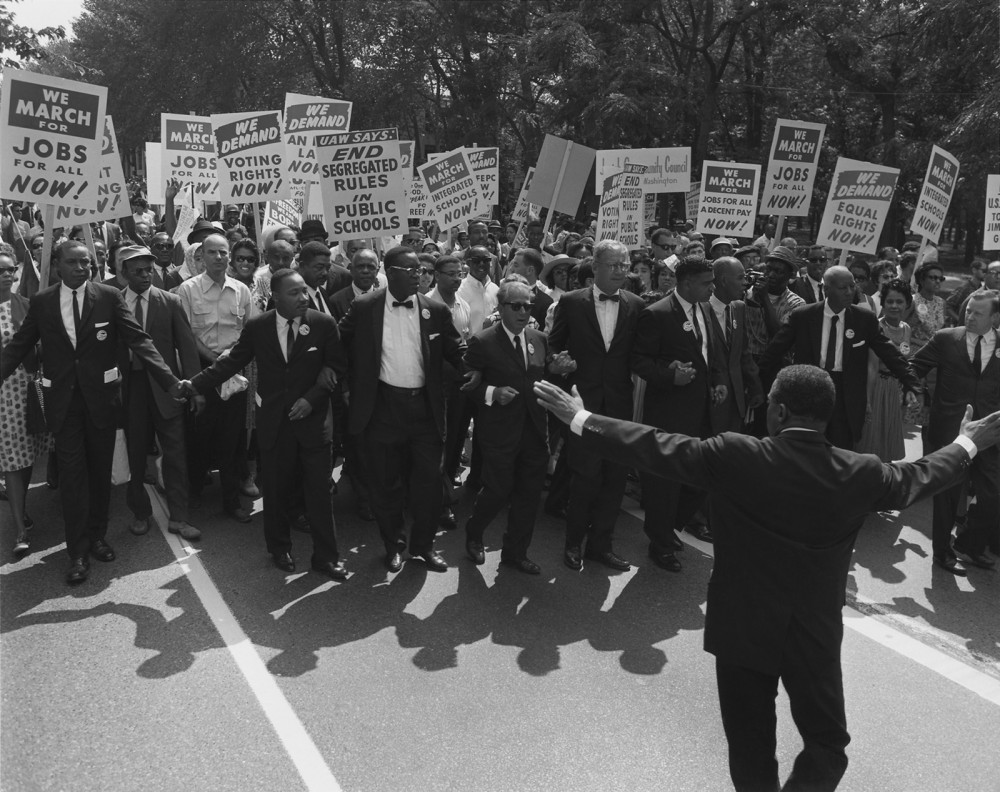 White activists increasingly joined African Americans in the Civil Rights Movement during the 1960s. This photograph shows Martin Luther King, Jr., and other black civil rights leaders arm-in-arm with leaders of the Jewish community. Photograph, August 28, 1963. Wikimedia, http://commons.wikimedia.org/wiki/File:March_on_washington_Aug_28_1963.jpg.
White activists increasingly joined African Americans in the Civil Rights Movement during the 1960s. This photograph shows Martin Luther King, Jr., and other black civil rights leaders arm-in-arm with leaders of the Jewish community. Photograph, August 28, 1963. Wikimedia, http://commons.wikimedia.org/wiki/File:March_on_washington_Aug_28_1963.jpg.
¶ 37 Leave a comment on paragraph 37 0 Kennedy offered support for a civil rights bill, but, unable to push past southern resistance and unwilling to expend too much political capital, the bill stalled in Congress. Then, on November 22, 1963, President Kennedy was assassinated in Dallas. The nation’s youthful, popular president was gone. Vice President Lyndon Johnson lacked Kennedy’s youth, his charisma, his popularity, and his aristocratic upbringing, but no one knew Washington better and no one before or since fought harder and more successfully to pass meaningful civil rights legislation. Raised in poverty in the Texas Hill Country, Johnson scratched and clawed his way up the political ladder. He was both ruthlessly ambitious and keenly conscious of poverty and injustice. He idolized Franklin Roosevelt, for instance, whose New Deal had brought improvements for the impoverished Central Texans Johnson grew up with.
¶ 38 Leave a comment on paragraph 38 0 President Lyndon Johnson, then, an old white southerner with a thick Texas drawl, embraced the civil rights movement. He took Kennedy’s stalled civil rights bill, ensured that it would have teeth, and navigated it through Congress. The following summer he signed the Civil Rights Act of 1964, widely considered to be among the most important pieces of civil rights legislation in American history. The comprehensive act barred segregation in public accommodations and outlawed discrimination based on race, ethnicity, gender, and national or religious origin.
¶ 39
Leave a comment on paragraph 39 0
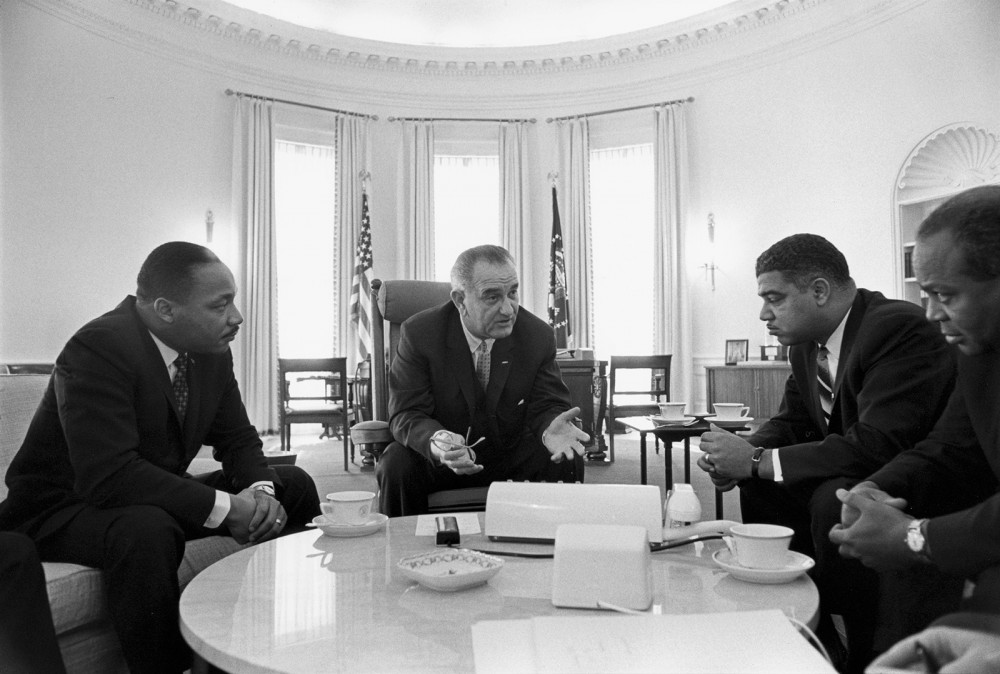 Lyndon B. Johnson sits with Civil Rights Leaders in the White House. One of Johnson’s greatest legacies would be his staunch support of civil rights legislation. Photograph, January 18, 1964. Wikimedia.
Lyndon B. Johnson sits with Civil Rights Leaders in the White House. One of Johnson’s greatest legacies would be his staunch support of civil rights legislation. Photograph, January 18, 1964. Wikimedia.
¶ 40
Leave a comment on paragraph 40 0
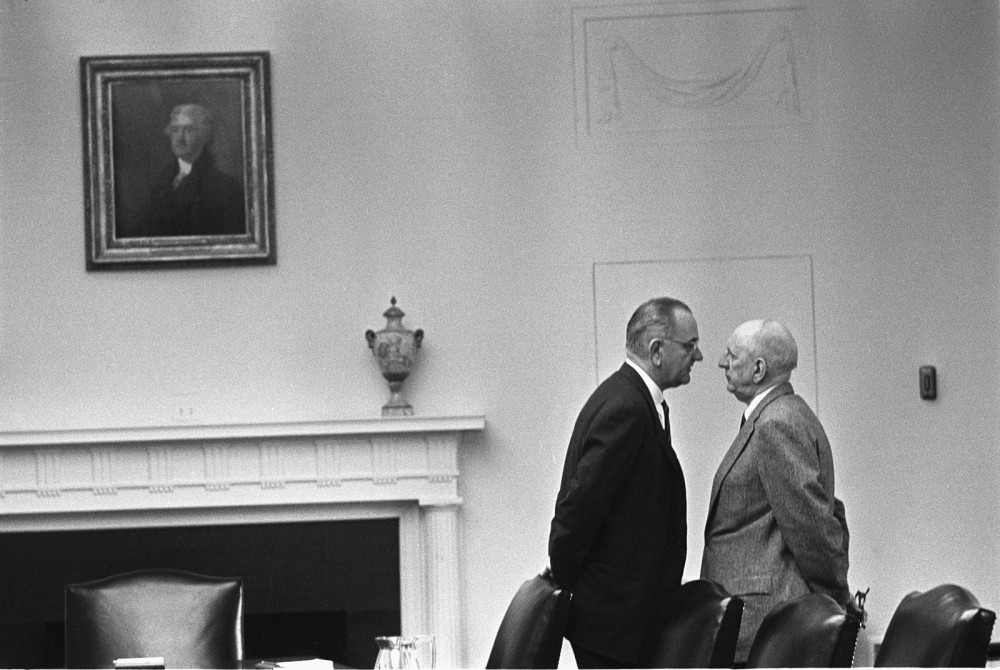 Johnson gives Senator Richard Russell the famous “Johnson Treatment.” Yoichi R. Okamoto, Photograph of Lyndon B. Johnson pressuring Senator Richard Russell, December 17, 1963. Wikimedia.
Johnson gives Senator Richard Russell the famous “Johnson Treatment.” Yoichi R. Okamoto, Photograph of Lyndon B. Johnson pressuring Senator Richard Russell, December 17, 1963. Wikimedia.
¶ 41 Leave a comment on paragraph 41 0 The civil rights movement created space for political leaders to pass legislation, and the movement continued pushing forward. Direct action continued through the summer of 1964, as student-run organizations like SNCC and CORE (The Congress of Racial Equality) helped with the Freedom Summer in Mississippi, a drive to register African American voters in a state with an ugly history of discrimination. Freedom Summer campaigners set up schools for African American children and endured intimidation tactics. Even with progress, violent resistance against civil rights continued, particularly in regions with longstanding traditions of segregation. ((Branch, Pillar.))
¶ 42 Leave a comment on paragraph 42 0 In March 1965, when activists attempted to march from Selma to Montgomery, Alabama, with the support of prominent civil rights leaders on behalf of local African American voting rights. In a narrative that had become familiar, “Bloody Sunday” featured peaceful protesters attacked by white law enforcement with batons and tear gas. After they were turned away violently a second time, marchers finally made the 70-mile trek to the state capitol later in the month. Coverage of the first march prompted President Johnson to present the bill that became the Voting Rights Act of 1965, an act that abolished voting discrimination in federal, state, and local elections. In two consecutive years, landmark pieces of legislation had assaulted de jure segregation and disenfranchisement. ((Branch, Canann’s Edge.))
¶ 43
Leave a comment on paragraph 43 0
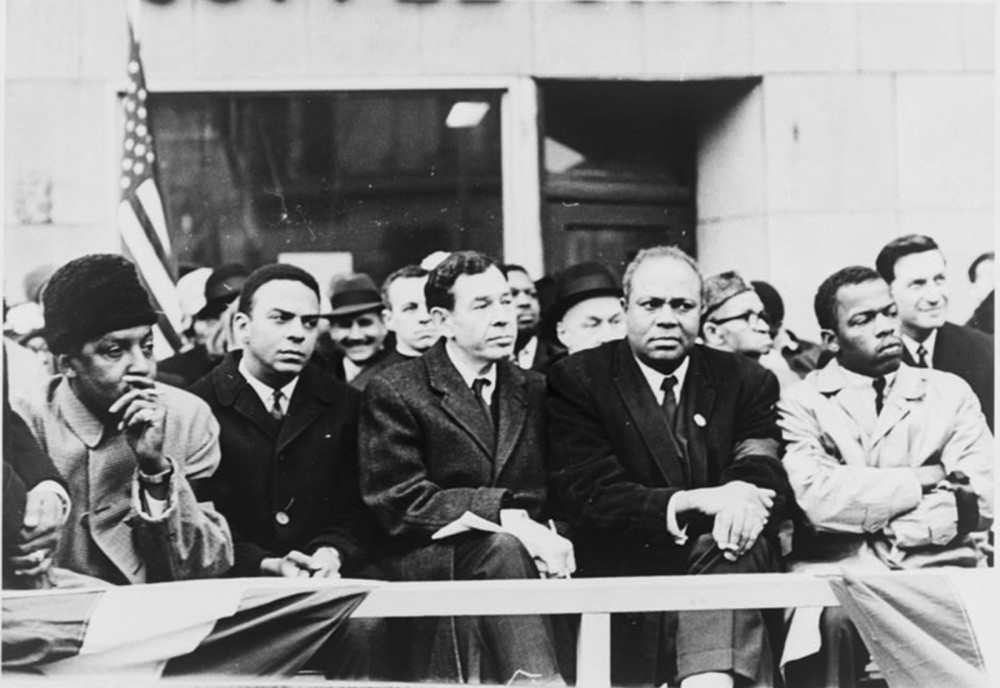 Five leaders of the Civil Rights Movement. From left: Bayard Rustin, Andrew Young, N.Y. Congressman William Ryan, James Farmer, and John Lewis in 1965. Stanley Wolfson, Photograph, 1965. Library of Congress, http://www.loc.gov/pictures/item/98515229/.
Five leaders of the Civil Rights Movement. From left: Bayard Rustin, Andrew Young, N.Y. Congressman William Ryan, James Farmer, and John Lewis in 1965. Stanley Wolfson, Photograph, 1965. Library of Congress, http://www.loc.gov/pictures/item/98515229/.
¶ 44 Leave a comment on paragraph 44 0
IV. Lyndon Johnson’s Great Society
¶ 45 Leave a comment on paragraph 45 0 On a May morning in 1964, President Johnson laid out a sweeping vision for a package of domestic reforms known as the Great Society. Speaking before that year’s graduates of the University of Michigan, Johnson called for “an end to poverty and racial injustice” and challenged both the graduates and American people to “enrich and elevate our national life, and to advance the quality of our American civilization.” At its heart, he promised, the Great Society would uplift racially and economically disfranchised Americans, too long denied access to federal guarantees of equal democratic and economic opportunity, while simultaneously raising all Americans’ standards and quality of life. ((Lyndon Baines Johnson, “Remarks at the University of Michigan,” May 22, 1964, Public Papers of the Presidents of the United States: Lyndon B. Johnson, 1964, (Washington, D.C.: Government Printing Office, 1965), 704.))
¶ 46 Leave a comment on paragraph 46 0 The Great Society’s legislation was breathtaking in scope, and many of its programs and agencies are still with us today. Most importantly, the Civil Rights Act of 1964 and the Voting Rights Act of 1965 codified federal support for many of the civil rights movement’s goals by prohibiting job discrimination, abolishing the segregation of public accommodations, and providing vigorous federal oversight of southern states’ primary and general election laws in order to guarantee minority access to the ballot. Ninety years after Reconstruction, these measures effectively ended Jim Crow.
¶ 47 Leave a comment on paragraph 47 0 In addition to civil rights, the Great Society took on a range of quality of life concerns that seemed suddenly solvable in a society of such affluence. It established the first federal Food Stamp Program. Medicare and Medicaid would ensure access to quality medical care for the aged and poor. In 1965, the Elementary and Secondary Education Act was the first sustained and significant federal investment in public education, totaling more than $1 billion. Significant funds were poured into colleges and universities. The Great Society also established the National Endowment for the Arts and the National Endowment for the Humanities, federal investments in arts and letters that fund American cultural expression to this day.
¶ 48 Leave a comment on paragraph 48 0 While these programs persisted and even thrived, in the years immediately following this flurry of legislative activity, the national conversation surrounding Johnson’s domestic agenda largely focused on the $3 billion spent on War on Poverty programming within the Great Society’s Economic Opportunity Act of 1964. No EOA program was more controversial than Community Action, considered the cornerstone antipoverty program. Johnson’s antipoverty planners felt the key to uplifting disfranchised and impoverished Americans was involving poor and marginalized citizens in the actual administration of poverty programs, what they called “maximum feasible participation.” Community Action Programs would give disfranchised Americans a seat at the table in planning and executing federally funded programs that were meant to benefit themselves—a significant sea change in the nation’s efforts to confront poverty, which had historically relied upon local political and business elites or charitable organizations for administration. ((See, for instance, Wesley G. Phelps, A People’s War on Poverty: Urban Politics and Grassroots Activists in Houston (Athens: University of Georgia Press, 2014).))
¶ 49 Leave a comment on paragraph 49 0 In fact, Johnson himself had never conceived of poor Americans running their own poverty programs. While the president’s rhetoric offered a stirring vision of the future, he had singularly old-school notions for how his poverty policies would work. In contrast to “maximum feasible participation,” the President imagined a second New Deal: local elite-run public works camps that would instill masculine virtues in unemployed young men. Community Action almost entirely bypassed local administrations and sought to build grassroots civil rights and community advocacy organizations, many of which had originated in the broader civil rights movement. Despite widespread support for most Great Society programs, the War on Poverty increasingly became the focal point of domestic criticisms from the left and right. On the left, frustrated liberals recognized the president’s resistance to empowering minority poor and also assailed the growing war in Vietnam, the cost of which undercut domestic poverty spending. As racial unrest and violence swept across urban centers, critics from the right lambasted federal spending for “unworthy” and even criminal citizens.
¶ 50 Leave a comment on paragraph 50 0 Johnson had secured a series of meaningful civil rights laws, but then things began to stall. Days after the ratification of the Voting Rights Act, race riots broke out in the Watts District of Los Angeles. Rioting in Watts stemmed from local African American frustrations with residential segregation, police brutality, and racial profiling. Waves of riots would rock American cities every summer thereafter. Particularly destructive riots occurred in 1967—two summers later—in Newark and Detroit. Each resulted in deaths, injuries, arrests, and millions of dollars in property damage. In spite of black achievements, inner-city problems persisted for many African Americans. The phenomenon of “white flight”—when whites in metropolitan areas fled city centers for the suburbs—often resulted in “re-segregated” residential patterns. Limited access to economic and social opportunities in urban areas bred discord. In addition to reminding the nation that the civil rights movement was a complex, ongoing event without a concrete endpoint, the unrest in northern cities reinforced the notion that the struggle did not occur solely in the South. Many Americans also viewed the riots as an indictment of the Great Society, President Johnson’s sweeping agenda of domestic programs that sought to remedy inner-city ills by offering better access to education, jobs, medical care, housing, and other forms of social welfare. The civil rights movement was never the same. ((Ibid.))
¶ 51 Leave a comment on paragraph 51 0 Despite the fact that the Civil Rights, the Voting Rights Acts, the War on Poverty provoked conservative resistance and were catalysts for the rise of Republicans in the South and West, subsequent presidents and Congresses have left largely intact the bulk of the Great Society. Many of its programs, such as Medicare and Medicaid, food stamps, federal spending for arts and literature, and Head Start, are considered by many to be effective forms of government action. Even Community Action programs, so fraught during their few short years of activity, inspired and empowered a new generation of minority and poverty community activists who had never before felt, as one put it, “this government is with us.” ((Guian A. McKee, “‘This Government is With Us’: Lyndon Jonson and the Grassroots War on Poverty,” in Annelise Orleck and Lisa Gayle Hazirjian, editors, The War on Poverty: A New Grassroots History, 1964-1980 (Athens: University of Georgia Press, 2011).))
¶ 52 Leave a comment on paragraph 52 0
V. The Origins of the Vietnam War
¶ 53 Leave a comment on paragraph 53 0 American involvement in the Vietnam War began during the postwar period of decolonization. The Soviet Union backed many nationalist movements across the globe, but the United States feared the expansion of communist influence and pledged to confront any revolutions aligned against western capitalism. The “domino theory”—the idea that if a country fell to communism, then neighboring states would soon follow—governed American foreign policy. After the communist takeover of China in 1949, the United States financially supported the French military’s effort to retain control over its colonies in Vietnam, Cambodia and Laos.
¶ 54 Leave a comment on paragraph 54 0 Between 1946 and 1954, France fought a counterinsurgency campaign against the nationalist Viet Minh forces led by Ho Chi Minh. The United States assisted the French war effort with funds, arms, and advisors, but it was not enough. On the eve of the Geneva Peace Conference in 1954, Viet Minh forces defeated the French army at Dien Bien Phu. The conference temporarily divided Vietnam into two separate states until United Nations-monitored elections occurred. But the U.S. feared a communist electoral victory and so blocked the elections. The temporary partition became permanent. The U.S. established the Republic of Vietnam, or South Vietnam, with the US-backed Ngo Dinh Diem as prime minister. Although he was a nationalist, Diem, who had lived in the United States, was a committed anti-communist.
¶ 55 Leave a comment on paragraph 55 0 Diem’s government, however, and its Army of the Republic of Vietnam (ARVN) could not contain the communist insurgency seeking the reunification of Vietnam. The Americans provided weapons and support, but, despite a clear numerical and technological advantage, South Vietnam’s stumbled before insurgent Vietcong (VC) units. Diem, a corrupt leader propped up by the American government with little domestic support, was assassinated in 1963. A merry-go-round of military dictators followed as the situation in South Vietnam continued to deteriorate. The American public, though, remained largely unaware of Vietnam in the early 1960s, even as President John F. Kennedy deployed some sixteen thousand military advisers to help South Vietnam suppress a domestic communist insurgency. ((Michael P. Sullivan, The Vietnam War: A Study in the Making of American Foreign Policy (Lexington: University Press of Kentucky, 1985), 58.))
¶ 56 Leave a comment on paragraph 56 0 This all changed in 1964. On August 2, the USS Maddox reported incoming fire from North Vietnamese ships in the Gulf of Tonkin. Although the details of the incident are controversial, the Johnson administration exploited the incident to provide a pretext for escalating American involvement in Vietnam. Congress passed the Gulf of Tonkin Resolution, granting President Johnson the authority to deploy the American military to defend South Vietnam. U.S. Marines landed in Vietnam in March, 1965, and the American ground war began.
¶ 57 Leave a comment on paragraph 57 0 American forces under General William Westmoreland were tasked with defending South Vietnam against the insurgent Vietcong (VC) and the regular North Vietnamese Army (NVA). But no matter how many troops the Americans sent, or how many bombs they dropped, they could not win. This was a different kind of war. Progress was not measured by cities won or territory taken, but by body counts and kill-ratios. Although American officials like Westmoreland and Secretary of Defense Robert McNamara claimed a communist defeat was on the horizon, by 1968 half-a-million American troops were stationed in Vietnam, nearly 20,000 had been killed, and the war was still no closer to being won. Protests, which would provide the backdrop for the American counterculture, erupted across the country.
¶ 58 Leave a comment on paragraph 58 0
VI. Culture and Activism
¶ 59
Leave a comment on paragraph 59 0
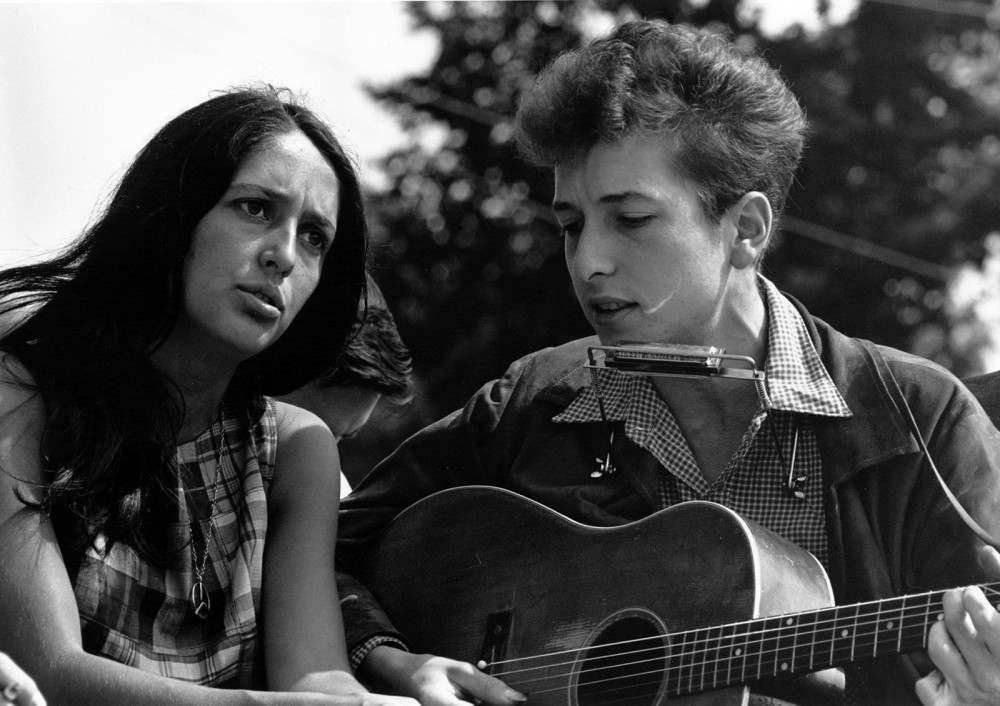 Epitomizing the folk music and protest culture of 1960s youth, Joan Baez and Bob Dylan are pictured here singing together at the March on Washington in 1963. Photograph, Wikimedia.
Epitomizing the folk music and protest culture of 1960s youth, Joan Baez and Bob Dylan are pictured here singing together at the March on Washington in 1963. Photograph, Wikimedia.
¶ 60 Leave a comment on paragraph 60 0 The 1960s wrought enormous cultural change. The United States that entered the decade looked and sounded little like the one that left it. Rebellion rocked the supposedly hidebound conservatism of the 1950s as the youth counterculture became mainstream. Native Americans, Chicanos, women, and environmentalists participated in movements demonstrating that “rights” activism could be applied to ethnicity, gender, and nature. Even established religious institutions such as the Catholic Church underwent transformations reflecting an emerging emphasis on freedom and tolerance. In each instance, the decade brought about substantial progress with a reminder that the activism in each cultural realm remained fluid and unfinished.
¶ 61 Leave a comment on paragraph 61 0 Much of the counterculture was filtered through popular culture and consumption. The fifties consumer culture still saturated the country and advertisers continued to appeal to teenagers and the expanding youth market. During the 1960s, though, advertisers looked to a growing counterculture to sell their products. Popular culture and popular advertising in the 1950s had promoted an ethos of “fitting in” and buying products to conform. The new countercultural ethos touted individuality and rebellion. Some advertisers were subtle; ads for Volkswagens acknowledged the flaws and strange look of their cars. One ad read, “Presenting America’s slowest fastback,” which “won’t go over 72 mph even though the speedometer shows a wildly optimistic top speed of 90.” Another stated, “And if you run out of gas, it’s easy to push.” By marketing the car’s flaws and reframing them as positive qualities, the advertisers commercialized young peoples’ resistance to commercialism. And it positioned the VW as a car for those who didn’t mind standing out in a crowd. A more obviously countercultural ad for the VW Bug showed two cars: one black and one painted multi-color in the hippie style; the contrasting captions read, “We do our thing,” and “You do yours.”
¶ 62
Leave a comment on paragraph 62 0
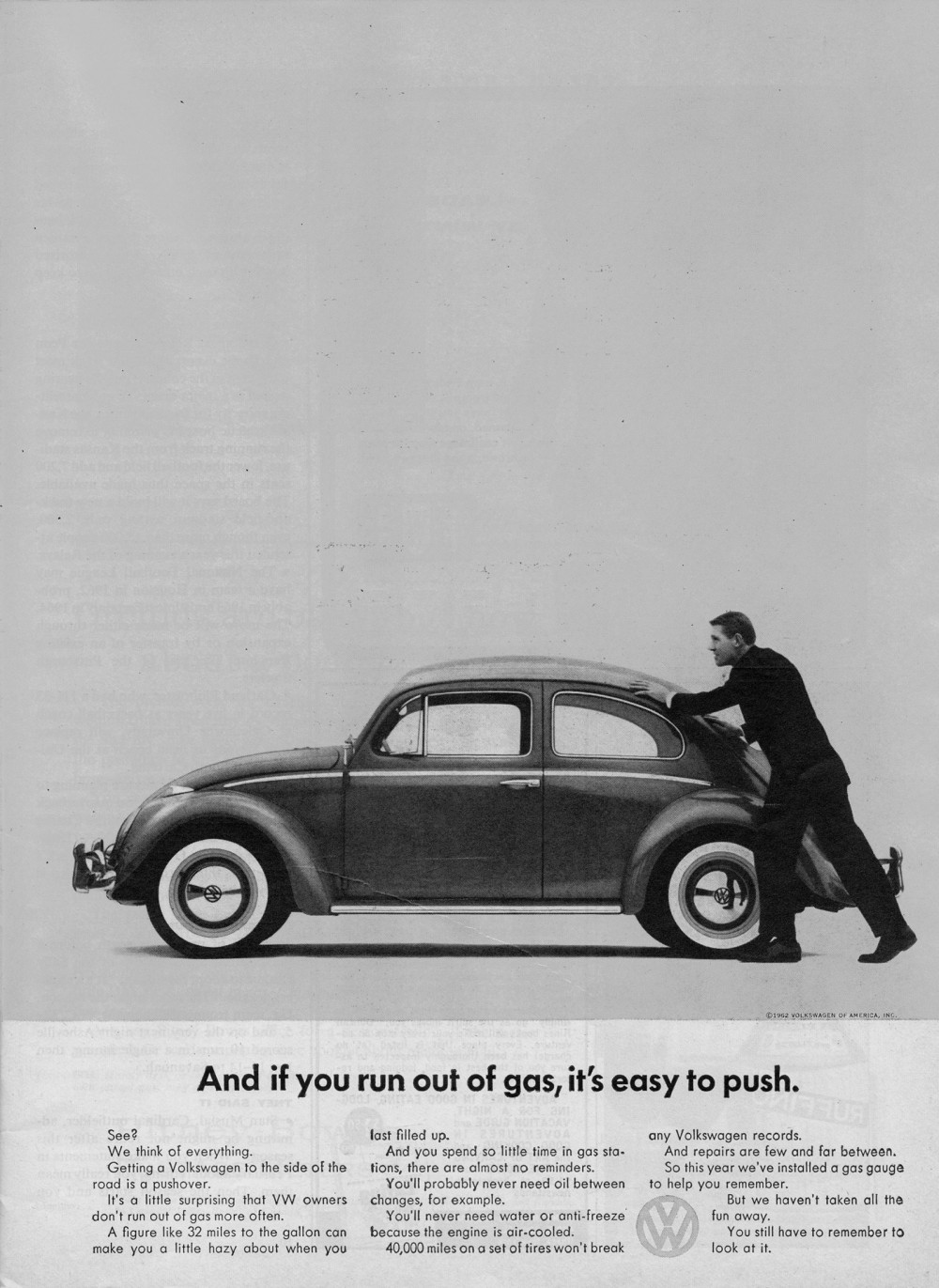 The Volkswagen Beetle became an icon of 1960s culture and a paradigm of a new advertising age. This tongue-in-cheek advertisement attracted laughs and attention from the public and business world. http://www.videosurrey.com/wp-content/uploads/2013/03/beetle-coccinelle-volkswagen-vw-publicite-vintage-03.jpg.
The Volkswagen Beetle became an icon of 1960s culture and a paradigm of a new advertising age. This tongue-in-cheek advertisement attracted laughs and attention from the public and business world. http://www.videosurrey.com/wp-content/uploads/2013/03/beetle-coccinelle-volkswagen-vw-publicite-vintage-03.jpg.
¶ 63 Leave a comment on paragraph 63 0 Companies marketed their products as countercultural in and of themselves. One of the more obvious examples was a 1968 ad from Columbia Records, a hugely successful record label since the 1920s. The ad pictured a group of stock rebellious characters—a shaggy-haired white hippie, a buttoned up Beat, two biker types, and a black jazz man sporting an afro—in a jail cell. The counterculture had been busted, the ad states, but “the man can’t bust our music.” Merely buying records from Columbia was an act of rebellion, one that brought the buyer closer to the counterculture figures portrayed in the ad. ((Thomas Frank, The Conquest of Cool: Business Culture, Counterculture, and the Rise of Hip Consumerism (Chicago: University of Chicago Press, 1998), 7.))
¶ 64 Leave a comment on paragraph 64 0 But it wasn’t just advertising: the culture was changing and changing rapidly. Conservative cultural norms were falling everywhere. The dominant style of women’s fashion in the 1950s, for instance, was the poodle skirt and the sweater, tight-waisted and buttoned up. The 1960s ushered in an era of much less restrictive clothing. Capri pants became popular casual wear. Skirts became shorter. When Mary Quant invented the miniskirt in 1964, she said it was a garment “in which you could move, in which you could run and jump.” ((Brenda Polan and Roger Tredre, The Great Fashion Designers (New York: Berg, 2009), 103-104.)) By the late 1960s, the hippies’ more androgynous look became trendy. Such trends bespoke the new popular ethos of the 1960s: freedom, rebellion, and individuality.
¶ 65
Leave a comment on paragraph 65 0
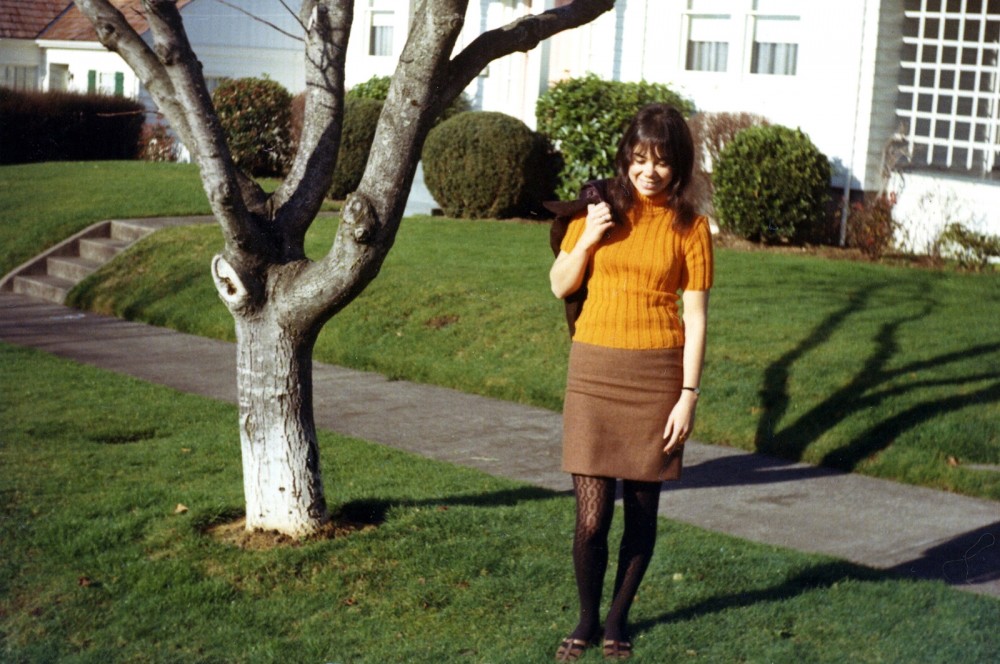 Fashion can sometimes capture a generation’s world view. Miniskirts – one of the most radical and popular fashions of the 1960s – demonstrated the new sexual openness of young women. Photograph of young woman in Eugene, Oregon, 1966. Wikimedia, http://commons.wikimedia.org/wiki/File:1960s_fashions_(1709303069).jpg.
Fashion can sometimes capture a generation’s world view. Miniskirts – one of the most radical and popular fashions of the 1960s – demonstrated the new sexual openness of young women. Photograph of young woman in Eugene, Oregon, 1966. Wikimedia, http://commons.wikimedia.org/wiki/File:1960s_fashions_(1709303069).jpg.
¶ 66 Leave a comment on paragraph 66 0 In a decade plagued by social and political instability, the American counterculture also sought psychedelic drugs as its remedy for alienation. For young, middle-class whites, society had become stagnant and bureaucratic. The New Left, for instance, arose on college campuses frustrated with the lifeless bureaucracies that they believed strangled true freedom. LSD began its life as a drug used primarily in psychological research before trickling down into college campuses and out into society at large. The counterculture’s notion that American stagnation could be remedied by a spiritual-psychedelic experience drew heavily from psychologists and sociologists. (By 1966, enough incidents had been connected to LSD to spur a Senate hearing on the drug and newspapers were reporting that hundreds of LSD users had been admitted to psychiatric wards.)
¶ 67 Leave a comment on paragraph 67 0 The counterculture conquered popular culture. Rock ‘n’ roll, liberalized sexuality, an embrace of diversity, recreational drug use, unalloyed idealism, and pure earnestness marked a new generation. Criticized by conservatives as culturally dangerous and by leftists as empty narcissism, the youth culture nevertheless dominated headlines and steered American culture. Perhaps 100,000 youth descended on San Francisco for the utopic promise of 1967’s Summer of Love. 1969’s Woodstock concert became shorthand for the new youth culture and its mixture of politics, protest, and personal fulfillment. While the ascendance of the hippies would be both exaggerated and short-lived, and while Vietnam and Richard Nixon shattered much of its idealism, the counterculture’s liberated social norms and its embrace of personal fulfillment still define much of American culture.
¶ 68 Leave a comment on paragraph 68 0
VII. Beyond Civil Rights
¶ 69 Leave a comment on paragraph 69 0 Despite substantial legislative achievements, frustrations with the slow pace of change and with the limits of the civil movement rose. Tensions continued to mount in cities and the tone of the civil rights movement changed yet again. Activists became less conciliatory in their calls for progress. Many embraced the more militant message of the burgeoning Black Power Movement and the late Malcolm X, a Nation of Islam (NOI) minister who had encouraged African Americans to pursue freedom, equality, and justice by “any means necessary.” Prior to his death, Malcolm X and the NOI emerged as the radical alternative to the racially integrated, largely Protestant approach of the Martin Luther King, Jr.-led civil rights movement. Malcolm advocated armed resistance in defense for the safety and well being of black Americans, stating, “I don’t call it violence when it’s self-defense, I call it intelligence.” For his part, King and leaders from more mainstream organizations like the NAACP and the Urban League criticized both Malcolm X and the NOI for what they perceived to be racial demagoguery. King believed Malcolm’s speeches were a “great disservice” to black Americans, claiming that X’s speeches lamented the problems of African Americans without offering solutions. The differences between Dr. King and Malcolm X represented a core ideological tension that would inhabit black political thought throughout the 1960s and 1970s. ((Manning Marable, Malcolm X: A Life of Reinvention (New York: Penguin, 2011).))
¶ 70
Leave a comment on paragraph 70 0
![Like Booker T. Washington and W.E.B. Du Bois before them, Martin Luther King, Jr., and Malcolm X represented two styles of racial uplift while maintaining the same general goal of ending racial discrimination. How they would get to that goal is where the men diverged. Marion S. Trikosko, “[Martin Luther King and Malcolm X waiting for press conference],” March 26, 1964. Library of Congress, http://www.loc.gov/pictures/item/92522562/.](http://www.americanyawp.com/text/wp-content/uploads/3d01847v-1000x651.jpg) Like Booker T. Washington and W.E.B. Du Bois before them, Martin Luther King, Jr., and Malcolm X represented two styles of racial uplift while maintaining the same general goal of ending racial discrimination. How they would get to that goal is where the men diverged. Marion S. Trikosko, “[Martin Luther King and Malcolm X waiting for press conference],” March 26, 1964. Library of Congress, http://www.loc.gov/pictures/item/92522562/.By the late 1960s, the Student Nonviolent Coordinating Committee (SNCC), led by figures such as Stokely Carmichael, had expelled its white members and shunned the interracial effort in the rural South, focusing instead on injustices in northern urban areas. After President Johnson refused to take up the cause of the black delegates in the Mississippi Freedom Democratic Party at the 1964 Democratic National Convention, SNCC activists became frustrated with institutional tactics and turned away from the organization’s founding principle of nonviolence over the course of the next year. This evolving, more aggressive movement called for African Americans to play a dominant role in cultivating black institutions and articulating black interests rather than relying on interracial, moderate approaches. At a June 1966 civil rights march, Carmichael told the crowd, “What we gonna start saying now is black power!” ((Peniel E. Joseph, editor, The Black Power Movement: Rethinking the Civil Rights-Black Power Era (New York: Routledge, 2013), 2.)) The slogan not only resonated with audiences, it also stood in direct contrast to King’s “Freedom Now!” campaign. The political slogan of black power could encompass many meanings, but at its core stood for the self-determination of blacks in political, economic, and social organizations.
Like Booker T. Washington and W.E.B. Du Bois before them, Martin Luther King, Jr., and Malcolm X represented two styles of racial uplift while maintaining the same general goal of ending racial discrimination. How they would get to that goal is where the men diverged. Marion S. Trikosko, “[Martin Luther King and Malcolm X waiting for press conference],” March 26, 1964. Library of Congress, http://www.loc.gov/pictures/item/92522562/.By the late 1960s, the Student Nonviolent Coordinating Committee (SNCC), led by figures such as Stokely Carmichael, had expelled its white members and shunned the interracial effort in the rural South, focusing instead on injustices in northern urban areas. After President Johnson refused to take up the cause of the black delegates in the Mississippi Freedom Democratic Party at the 1964 Democratic National Convention, SNCC activists became frustrated with institutional tactics and turned away from the organization’s founding principle of nonviolence over the course of the next year. This evolving, more aggressive movement called for African Americans to play a dominant role in cultivating black institutions and articulating black interests rather than relying on interracial, moderate approaches. At a June 1966 civil rights march, Carmichael told the crowd, “What we gonna start saying now is black power!” ((Peniel E. Joseph, editor, The Black Power Movement: Rethinking the Civil Rights-Black Power Era (New York: Routledge, 2013), 2.)) The slogan not only resonated with audiences, it also stood in direct contrast to King’s “Freedom Now!” campaign. The political slogan of black power could encompass many meanings, but at its core stood for the self-determination of blacks in political, economic, and social organizations.
¶ 71 Leave a comment on paragraph 71 0
¶ 72 Leave a comment on paragraph 72 0
¶ 73 Leave a comment on paragraph 73 0
¶ 74 Leave a comment on paragraph 74 0
¶ 75 Leave a comment on paragraph 75 0
¶ 76
Leave a comment on paragraph 76 0
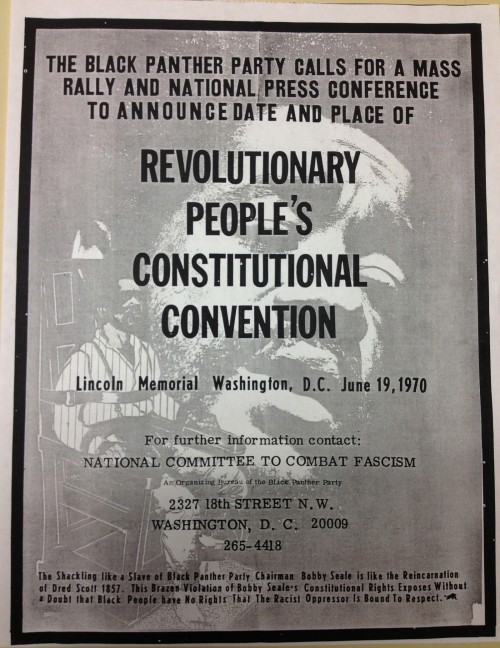 The Black Panther Party used radical and incendiary tactics to bring attention to the continued oppression of blacks in America. Read the bottom paragraph on this rally poster carefully. Wikimedia.
The Black Panther Party used radical and incendiary tactics to bring attention to the continued oppression of blacks in America. Read the bottom paragraph on this rally poster carefully. Wikimedia.
¶ 77 Leave a comment on paragraph 77 0 While Carmichael asserted that “black power means black people coming together to form a political force,” to many it also meant violence. ((Gordon Parks “Whip of Black Power,” LIFE (May 19, 1967), 82.)) In 1966, Huey Newton and Bobby Seale formed the Black Panther Party in Oakland, California. The Black Panthers became the standard-bearers for direct action and self-defense, using the concept of “decolonization” in their drive to liberate black communities from white power structures. The revolutionary organization also sought reparations and exemptions for black men from the military draft. Citing police brutality and racist governmental policies, the Panthers aligned themselves with the “other people of color in the world” against whom America was fighting abroad. Although it was perhaps most well-known for its open display of weapons, military-style dress, and black nationalist beliefs, the Party’s 10-Point Plan also included employment, housing, and education. The Black Panthers worked in local communities to run “survival programs” that provided food, clothing, medical treatment, and drug rehabilitation. They focused on modes of resistance that empowered black activists on their own terms. ((Joshua Bloom and Waldo E. Martin, Jr., Black against Empire: The History and Politics of the Black Panther Party (Berkeley: University of California Press, 2012).))
¶ 78 Leave a comment on paragraph 78 0 But African Americans weren’t the only Americans struggling to assert themselves in the 1960s . The successes of the civil rights movement and growing grassroots activism inspired countless new movements. In the summer of 1961, for instance, frustrated Native American university students founded the National Indian Youth Council (NIYC) to draw attention to the plight of indigenous Americans. In the Pacific Northwest, the Council advocated for tribal fisherman to retain immunity from conservation laws on reservations and in 1964 held a series of “fish-ins”: activists and celebrities cast nets and waited for the police to arrest them. ((In 1974, fishing rights activists and tribal leaders reached a legal victory in United States v. Washington, otherwise known as the Boldt Decision, which declared that Native Americans were entitled to up to 50 percent of the fish caught in the “usual and accustomed places,” as stated in 1850s treaties.)) NIYC’s militant rhetoric and use of direct action marked the beginning of what was called the Red Power movement, an intertribal movement designed to draw attention to Native issues and protest discrimination. The American Indian Movement (AIM) and other activists staged dramatic demonstrations. In November 1969, dozens began a year-and-a-half occupation of the abandoned Alcatraz Island, in San Francisco Bay. In 1973, hundreds occupied the town of Wounded Knee, South Dakota, site of an infamous 1890 Indian massacre, for several months. ((Paul Chaat Smith and Robert Allen Warrior, Like a Hurricane: The Indian Movement from Alcatraz to Wounded Knee (New York: The New Press, 1997).))
¶ 79
Leave a comment on paragraph 79 0
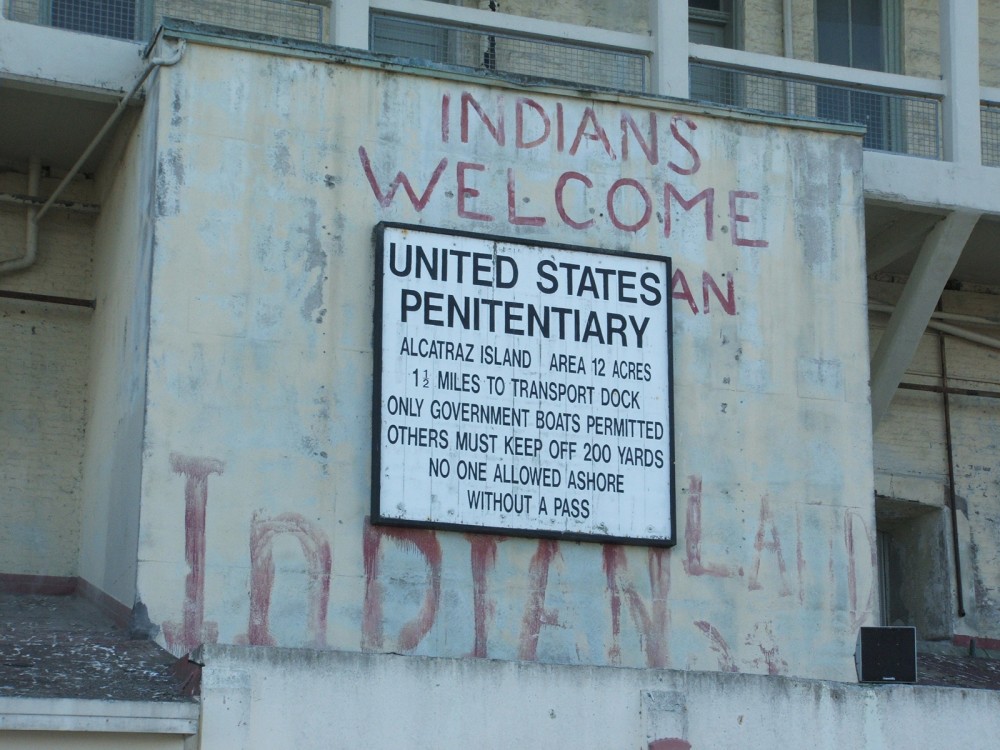 While the Pan-Indian movement faded, a sign remains of the Native American occupation of Alcatraz Island in the San Francisco Bay. Photograph, July 18, 2006. Wikimedia,
While the Pan-Indian movement faded, a sign remains of the Native American occupation of Alcatraz Island in the San Francisco Bay. Photograph, July 18, 2006. Wikimedia,
¶ 80 Leave a comment on paragraph 80 0 Meanwhile, the Chicano movement in the 1960s emerged out of the broader Mexican American civil rights movement of the post-World War II era. While “Chicano” was initially considered a derogatory term for Mexican immigrants, activists in the 1960s reclaimed the term and used it as a catalyst to campaign for political and social change among Mexican Americans. The Chicano movement confronted discrimination in schools, politics, agriculture, and other formal and informal institutions. Organizations like the Mexican American Political Association (MAPA) and the Mexican American Legal Defense Fund (MALDF) buoyed the Chicano movement and patterned themselves after similar influential groups in the African American civil rights movement. (See, for instance, Juan Gómez-Quiñones and Irene Vásquez Making Aztlán: Ideology and Culture of the Chicana and Chicano Movement, 1966-1977 (Albuquerque: University of New Mexico Press, 2014).))
¶ 81 Leave a comment on paragraph 81 0 Cesar Chavez became the most well-known figure of the Chicano movement, using nonviolent tactics to campaign for workers’ rights in the grape fields of California. Chavez and activist Dolores Huerta founded the National Farm Workers Association, which eventually merged and became the United Farm Workers of America (UFWA). The UFWA fused the causes of Chicano and Filipino activists protesting subpar working conditions of California farmers on American soil. In addition to embarking on a hunger strike and a boycott of table grapes, Chavez led a 300-mile march in March and April of 1966 from Delano, California to the state capital of Sacramento. The pro-labor campaign garnered the national spotlight and the support of prominent political figures such as Robert Kennedy. Today, Chavez’s birthday (March 31) is observed as a federal holiday in California, Colorado, and Texas.
¶ 82
Leave a comment on paragraph 82 0
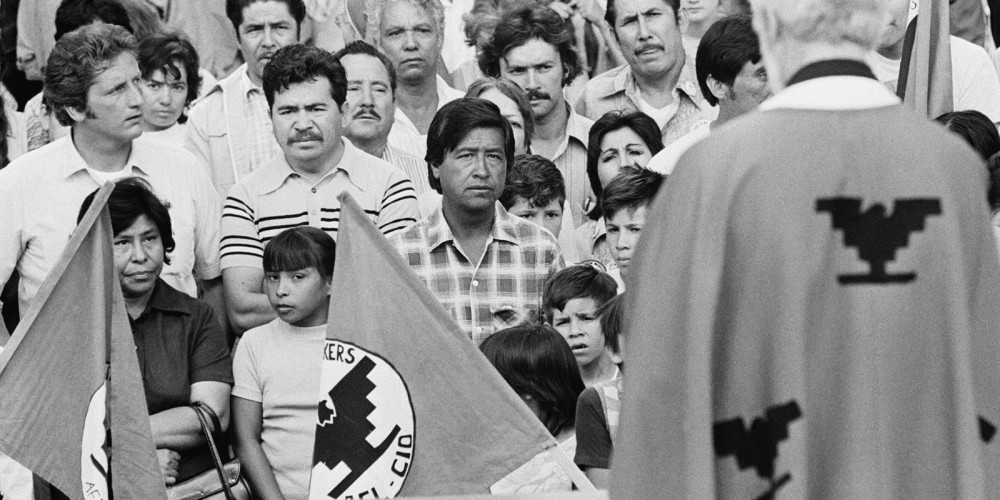 The United Farm Workers Union become a strong force for bettering working conditions of laborers in California and Florida agriculture. Cesar Chavez (center) and UFW supporters attend an outdoor Mass on the capitol steps in Sacramento, Calif., before start of a labor protest march, date unknown. Huffington Post.
The United Farm Workers Union become a strong force for bettering working conditions of laborers in California and Florida agriculture. Cesar Chavez (center) and UFW supporters attend an outdoor Mass on the capitol steps in Sacramento, Calif., before start of a labor protest march, date unknown. Huffington Post.
¶ 83 Leave a comment on paragraph 83 0 Rodolfo “Corky” Gonzales was another activist whose calls for Chicano self-determination resonated long past the 1960s. A former boxer and Denver native, Gonzales founded the Crusade for Justice in 1966, an organization that would establish the first annual Chicano Liberation Day at the National Chicano Youth Conference by decade’s end. The conference also yielded the Plan Espiritual de Aztlan, a Chicano nationalist manifesto that reflected Gonzales’ vision of Chicano as a unified, historically grounded, all-encompassing group fighting against discrimination in the United States. By 1970, the Texas-based La Raza Unida political party had a strong foundation for promoting Chicano nationalism and continuing the campaign for Mexican American civil rights. ((Armando Navarro, Mexican American Youth Organization: Avant-Garde of the Movement in Texas (Austin: University of Texas Press, 1995); Ignacio M. Garcia, United We Win: The Rise and Fall of La Raza Unida Party (Tucson: University of Arizona Mexican American Studies Research Center, 1989).))
¶ 84
Leave a comment on paragraph 84 0
 The 1966 Rio Grande Valley Farm Workers March (“La Marcha”). August 27, 1966. Via the University of Texas-San Antonio Libraries’ Special Collections (MS 360: E-0012-187-D-16)
The 1966 Rio Grande Valley Farm Workers March (“La Marcha”). August 27, 1966. Via the University of Texas-San Antonio Libraries’ Special Collections (MS 360: E-0012-187-D-16)
¶ 85 Leave a comment on paragraph 85 0 The feminist movement also made great strides in the 1960s. Women were active in both the civil rights movement and the labor movement, but their increasing awareness of gender inequality did not find a receptive audience among male leaders in those movements. In the 1960s, then, many of these women began to form a movement of their own. Soon the country experienced a groundswell of feminist consciousness.
¶ 86 Leave a comment on paragraph 86 0 An older generation of women who preferred to work within state institutions figured prominently in the early part of the decade. When John F. Kennedy established the President’s Commission on the Status of Women in 1961, former first lady Eleanor Roosevelt headed the effort. The Commission’s Invitation to Action was released in 1963. Finding discriminatory provisions in the law and practices of industrial, labor, and governmental organizations, the Commission advocated for “changes, many of them long overdue, in the conditions of women’s opportunity in the United States.” Change was necessary in areas of employment practices, federal tax and benefit policies affecting women’s income, labor laws, and services for women as wives, mothers, and workers. This call for action, if heeded, would ameliorate the types of discrimination primarily experienced by middle-class and elite white working women, all of whom were used to advocating through institutional structures like government agencies and unions. ((Flora Davis, Moving the Mountain: The Women’s Movement in America since 1960 (Champaign: University of Illinois, 1999); Cynthia Ellen Harrison, On Account of Sex: The Politics of Women’s Issues, 1945–1968 (Berkeley: University of California Press, 1988).))
¶ 87 Leave a comment on paragraph 87 0 Betty Friedan’s Feminine Mystique hit bookshelves the same year the Commission released its report. Friedan had been active in the union movement, and was by this time a mother in the new suburban landscape of post-war America. In her book, Friedan labeled the “problem that has no name,” and in doing so helped many white middle-class American women come to see their dissatisfaction as housewives not as something “wrong with [their] marriage, or [themselves],” but instead as a social problem experienced by millions of American women. Friedan observed that there was a “discrepancy between the reality of our lives as women and the image to which we were trying to conform, the image I call the feminine mystique.” No longer would women allow society to blame the “problem that has no name” on a loss of femininity, too much education, or too much female independence and equality with men. ((Betty Friedan, The Feminine Mystique (New York: Norton, 1963), 50.))
¶ 88 Leave a comment on paragraph 88 0 The 1960s also saw a different group of women pushing for change in government policy. Welfare mothers began to form local advocacy groups in addition to the National Welfare Rights Organization founded in 1966. Mostly African American, these activists fought for greater benefits and more control over welfare policy and implementation. Women like Johnnie Tillmon successfully advocated for larger grants for school clothes and household equipment in addition to gaining due process and fair administrative hearings prior to termination of welfare entitlements.
¶ 89 Leave a comment on paragraph 89 0 Yet another mode of feminist activism was the formation of consciousness-raising groups. These groups met in women’s homes and at women’s centers, providing a safe environment for women to discuss everything from experiences of gender discrimination to pregnancy, from relationships with men and women to self-image. The goal of consciousness-raising was to increase self-awareness and validate the experiences of women. Groups framed such individual experiences as examples of society-wide sexism, and claimed that “the personal is political.” ((Carol Hanisch, “The Personal is Political,” in Shulamith Firestone and Anne Koedt, editors, Notes from the Second Year: Women’s Liberation (New York: Radical Feminism, 1970).)) Consciousness-raising groups created a wealth of personal stories that feminists could use in other forms of activism and crafted networks of women that activists could mobilize support for protests.
¶ 90 Leave a comment on paragraph 90 0 The end of the decade was marked by the Women’s Strike for Equality celebrating the 50th anniversary of women’s right to vote. Sponsored by NOW (the National Organization for Women), the 1970 protest focused on employment discrimination, political equality, abortion, free childcare, and equality in marriage. All of these issues foreshadowed the backlash against feminist goals in the 1970s. Not only would feminism face opposition from other women who valued the traditional homemaker role to which feminists objected, the feminist movement would also fracture internally as minority women challenged white feminists’ racism and lesbians vied for more prominence within feminist organizations.
¶ 91
Leave a comment on paragraph 91 0
![The women’s movement stagnated after gaining the vote in 1920, but by the 1960s it was back in full force. Inspired by the Civil Rights Movement and fed up with gender discrimination, women took to the streets to demand their rights as American citizens. Warren K. Leffler, “Women's lib[eration] march from Farrugut Sq[uare] to Layfette [i.e., Lafayette] P[ar]k,” August 26, 1970. Library of Congress, http://www.loc.gov/pictures/item/2003673992/.](http://www.americanyawp.com/text/wp-content/uploads/03425v-1000x675.jpg) The women’s movement stagnated after gaining the vote in 1920, but by the 1960s it was back in full force. Inspired by the Civil Rights Movement and fed up with gender discrimination, women took to the streets to demand their rights as American citizens. Warren K. Leffler, “Women’s lib[eration] march from Farrugut Sq[uare] to Layfette [i.e., Lafayette] P[ar]k,” August 26, 1970. Library of Congress, http://www.loc.gov/pictures/item/2003673992/.American environmentalism’s significant gains during the 1960s emerged in part from Americans’ recreational use of nature. Postwar Americans backpacked, went to the beach, fished, and joined birding organizations in greater numbers than ever before. These experiences, along with increased formal education, made Americans more aware of threats to the environment and, consequently, to themselves. Many of these threats increased in the post-war years as developers bulldozed open space for suburbs and new hazards from industrial and nuclear pollutants loomed over all organisms.
The women’s movement stagnated after gaining the vote in 1920, but by the 1960s it was back in full force. Inspired by the Civil Rights Movement and fed up with gender discrimination, women took to the streets to demand their rights as American citizens. Warren K. Leffler, “Women’s lib[eration] march from Farrugut Sq[uare] to Layfette [i.e., Lafayette] P[ar]k,” August 26, 1970. Library of Congress, http://www.loc.gov/pictures/item/2003673992/.American environmentalism’s significant gains during the 1960s emerged in part from Americans’ recreational use of nature. Postwar Americans backpacked, went to the beach, fished, and joined birding organizations in greater numbers than ever before. These experiences, along with increased formal education, made Americans more aware of threats to the environment and, consequently, to themselves. Many of these threats increased in the post-war years as developers bulldozed open space for suburbs and new hazards from industrial and nuclear pollutants loomed over all organisms.
¶ 92 Leave a comment on paragraph 92 0
¶ 93 Leave a comment on paragraph 93 0
¶ 94 Leave a comment on paragraph 94 0
¶ 95 Leave a comment on paragraph 95 0
¶ 96 Leave a comment on paragraph 96 0
¶ 97 Leave a comment on paragraph 97 0
¶ 98 Leave a comment on paragraph 98 0 By the time that biologist Rachel Carson published her landmark book, Silent Spring, in 1962, a nascent environmentalism had emerged in America. Silent Spring stood out as an unparalleled argument for the interconnectedness of ecological and human health. Pesticides, Carson argued, also posed a threat to human health, and their over-use threatened the ecosystems that supported food production. Carson’s argument was compelling to many Americans, including President Kennedy, and was virulently opposed by chemical industries that suggested the book was the product of an emotional woman, not a scientist. ((Rachel Carson, Silent Spring (New York: Houghton Mifflin, 1962; Linda Lear, Rachel Carson: Witness for Nature (New York: Henry Holt and Company, 1997).))
¶ 99 Leave a comment on paragraph 99 0 After Silent Spring, the social and intellectual currents of environmentalism continued to expand rapidly, culminating in the largest demonstration in history, Earth Day, on April 22, 1970, and in a decade of lawmaking that significantly restructured American government. Even before the massive gathering for Earth Day, lawmakers from the local to federal level had pushed for and achieved regulations to clean up the air and water. President Richard Nixon signed the National Environmental Policy Act into law in 1970, requiring environmental impact statements for any project directed or funded by the federal government. He also created the Environmental Protection Agency, the first agency charged with studying, regulating, and disseminating knowledge about the environment. A raft of laws followed that were designed to offer increased protection for air, water, endangered species, and natural areas.
¶ 100 Leave a comment on paragraph 100 0 The decade’s activism worked all across society. It even affected the Catholic Church. The Second Vatican Council, called by Pope John XXIII to modernize the church and bring it in closer dialogue with the non-Catholic world, operated from 1962 to 1965, when it proclaimed multiple reforms, including the “vernacular mass” (or, mass in local languages, rather than in Latin) and a greater role for laypeople, and especially women, in the Church. Many Catholic churches adopted more informal, contemporary styles. Many conservative Catholics recoiled at what they perceived as rapid and dangerous changes, but Vatican II’s reforms in many ways created the modern Catholic Church.
¶ 101
Leave a comment on paragraph 101 0
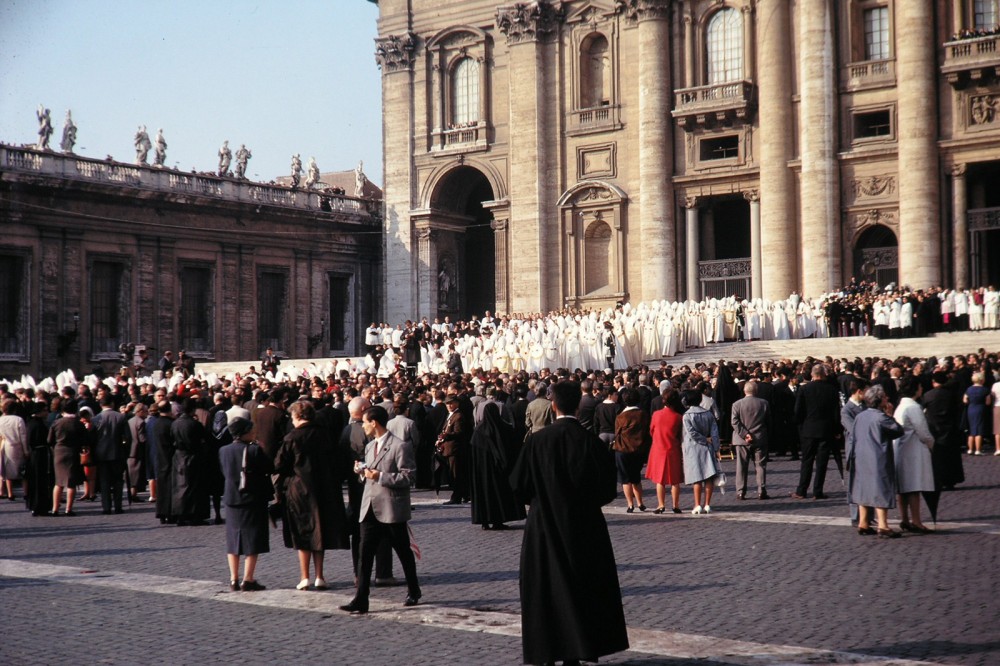 Losing membership and influence throughout the world, leaders of the Catholic Church met in 1965 institute new measures to modernize and open the church. This ecumenical council would become known as the Second Vatican Council or Vatican II. Photograph of the grand procession of the Council Fathers at St. Peter’s Basilica, October 11, 1962. Wikimedia.
Losing membership and influence throughout the world, leaders of the Catholic Church met in 1965 institute new measures to modernize and open the church. This ecumenical council would become known as the Second Vatican Council or Vatican II. Photograph of the grand procession of the Council Fathers at St. Peter’s Basilica, October 11, 1962. Wikimedia.
¶ 102 Leave a comment on paragraph 102 0
VIII. Conclusion
¶ 103 Leave a comment on paragraph 103 0 In 1969, Americans hailed the moon landing as a profound victory in the “space race” against the Soviet Union that fulfilled the promise of the late John F. Kennedy, who had declared in 1961 that the U.S. would put a man on the moon by the end of the decade. But while Neil Armstrong said his steps marked “one giant leap for mankind,” and Americans marveled at the achievement, the brief moment of wonder only punctuated years of turmoil. The Vietnam War disillusioned a generation, riots rocked cities, protests hit campuses, and assassinations robbed the nation of many of its leaders. The forward-thinking spirit of a complex decade had waned. Uncertainty loomed.
¶ 104 Leave a comment on paragraph 104 0
IX. Reference Material
¶ 105 Leave a comment on paragraph 105 0 This chapter was edited by Samuel Abramson, with content contributions by Samuel Abramson, Marsha Barrett, Brent Cebul, Michell Chresfield, William Cossen, Jenifer Dodd, Michael Falcone, Leif Fredrickson, Jean-Paul de Guzman, Jordan Hill, William Kelly, Lucie Kyrova, Maria Montalvo, Emily Prifogle, Ansley Quiros, Tanya Roth, and Robert Thompson.
Recommended citation: Samuel Abramson et al., “The Sixties,” Samuel Abramson, ed., in The American Yawp, Joseph Locke and Ben Wright, eds., last modified August 1, 2016, http://www.AmericanYawp.com.
¶ 107 Leave a comment on paragraph 107 0 Recommended Reading
- ¶ 108 Leave a comment on paragraph 108 1
- Branch, Taylor. Parting the Waters: America in the King Years, 1954–1963. New York: Simon & Schuster, 1988.
- Branch, Taylor. Pillar of Fire: America in the King Years, 1963-65. New York: Simon & Schuster, 1998.
- Brick, Howard. The Age of Contradictions: American Thought and Culture in the 1960s. Ithaca: Cornell University Press, 2000.
- Carson, Clayborne. In Struggle: SNCC and the Black Awakening of the 1960s. Cambridge: Harvard University Press, 1981.
- Dallek, Robert. Flawed Giant: Lyndon Johnson and His Times, 1961-1973. New York: Oxford University Press, 1993.
- Hall, Jacquelyn Dowd. “The Long Civil Rights Movement and the Political Uses of the Past,” Journal of American History 91 (March 2005): 1233-1263.
- Gitlin, Todd. The Sixties: Years of Hope, Days of Rage. New York: Bantam Books, 1987
- Isserman, Maurice. If I Had a Hammer: The Death of the Old Left and the Birth of the New Left. Champaign: University of Illinois Press, 1987.
- McGirr, Lisa. Suburban Warriors: The Origins of the New American Right. Princeton: Princeton University Press, 2001.
- Patterson, James T. Grand Expectations: The United States, 1945–1974. New York: Oxford University Press, 1996.
- Johnson, Troy R. The American Indian Occupation of Alcatraz Island: Red Power and Self-Determination. Lincoln: University of Nebraska Press, 2008.
- Joseph, Peniel. Waiting ‘til the Midnight Hour: A Narrative History of Black Power in America. New York: Holt, 2006.
- Kazin, Michael, and Isserman, Maurice. America Divided: The Civil War of the 1960s. New York: Oxford University Press, 2007.
- Perlstein, Rick. Before the Storm : Barry Goldwater and the Unmaking of the American Consensus. New York: Hill & Wang, 2001.
- Sugrue, Thomas, The Origins of the Urban Crisis: Race and Inequality in Postwar Detroit. Princeton, NJ: Princeton University Press, 2005.
¶ 109 Leave a comment on paragraph 109 0
¶ 110 Leave a comment on paragraph 110 0 Notes
I’m using American Yawp for the first time this year. I greatly appreciate this resource, as I’ve been looking for an option like this. I do hope, though, that you consider updating the civil rights section. The coverage of the civil rights movement in American Yawp is at least 15 years behind the field.